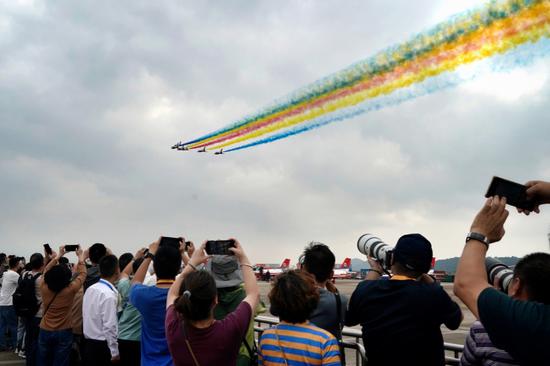Nation's space shuttle set to improve efficiency, cut costs

The August 1st Air Demonstration Team makes contrails to celebrate the 75th anniversary of the founding of the People's Liberation Army Air Force during a training session on Monday in Zhuhai, Guangdong province. The 15th China International Aviation and Aerospace Exhibition, also known as the Zhuhai Airshow, starts on Tuesday. (ZHOU GUOQIANG/FOR CHINA DAILY)
The Aviation Industry Corp of China is a major hardware supplier to the People's Liberation Army Air Force, Navy and Ground Force. And now, it has earned a new client — the China Manned Space Agency.
A reusable cargo spaceplane, one of the company's latest products, has gained the AVIC a contract from the space agency, which runs China's crewed spaceflights.
According to the State-owned defense conglomerate, the Haolong space shuttle, designed by its Chengdu Aircraft Design and Research Institute in Sichuan province, aims to further reduce the cargo transportation costs involved in the operation of China's Tiangong space station.
Zhang Jichao, a deputy general manager of the AVIC, said at a news conference in Zhuhai, Guangdong province, on Monday that the space shuttle's conceptual plan has been finalized and researchers have started the design and production work for the first prototype's components.
"Once put into service, Haolong will be launched by China's commercial carrier rockets to dock with the country's Tiangong space station. After completing its tasks, the shuttle will return to the Earth's atmosphere and make a horizontal landing on a runway like a plane," Zhang said.
"The model features good reusability and can ferry materials back and forth between the space station and Earth," he added.
Zhang said the use of such a spaceplane will significantly cut the time that mission planners now have to wait for between two cargo flights, and reduce the cost of each flight.
Compared with traditional cargo vessels that cannot be reused, the shuttle will be able to bring goods back to Earth, which will greatly facilitate scientific experiments, according to the executive.
Fang Yuanpeng, Haolong's chief designer, said the space shuttle will be about 10 meters long and eight meters wide. It will have two foldable curved wings, a vertical fin and will generate power via solar panels. During its docking with the space station, astronauts can move into it to take materials or store items, he noted.
A model of the spacecraft will be displayed at the 15th China International Aviation and Aerospace Exhibition, which opens on Tuesday in Zhuhai and runs through Sunday.
Currently, China has only one model of cargo spaceship, Tianzhou, which is a product of the China Academy of Space Technology in Beijing. So far, seven Tianzhou vessels have been launched and six of them were used to transport supplies to the Tiangong space station.
Orbiting Earth at a distance of about 400 kilometers, the Chinese space station has three permanent parts — a core module and two science capsules — and is regularly connected to several visiting crew and cargo spaceships.
It has been manned by eight Chinese crews, including the incumbent Shenzhou XIX team. All of the crews' living and work necessities need to be transported by cargo vessels.
